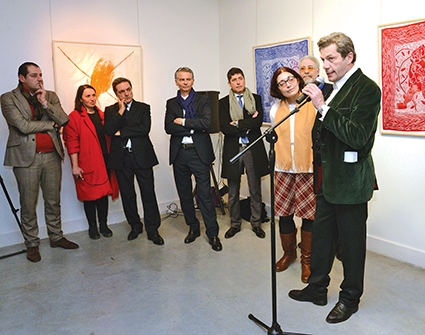Silk Scarves Grace Rustaveli
As if anticipating spring, a world-famous collection of silk scarves come direct from France presented itself to Tbilisi last Friday at a crowded event in the Georgian National Museum Dimitri Shevardnadze National Gallery. The special exhibition – “Les Foulards De La Gallerie Maeght” – presents nearly fifty scarves from the collection of the France-based Maeght Gallery, designed by acclaimed modern artists from the world over.
Maeght is a colossal name in the world of contemporary art. At least as far back as the 1930s the family, under its patriarch Aime Maeght, was attracting attention as an important patron and collector. Following the death of their son, Marguerite and Aime Maeght acted on the advice of a group of friends – Georges Braques, Jean Miro, and Ferdenand Leger – and transformed their summer home in the south of France, near Nice, into the Maeght Foundation. Today, the entirely private Maeght Foundation is one of the largest and most important collections of contemporary art in Europe, with over 120,000 works and an average of 200,000 visitors a year. The Maeght Gallery in Paris and in Barcelona stands as a complement even to this. The Foundation itself turned 50 two years ago.
Almost since the very beginning a tradition has existed, born from the friendly relationship between the elder Maeght and Joseph Brochier, a silk maker from Lyon and owner of the
Brochier-Soieries factory, to create silk scarves using Mr. Brochier’s fabric and designs from the sketches of artists in Mr. Maeght’s collection. This unusual confluence of private patronage, contemporary art, industry, and fashion has become a story and an attraction in its own right.
It is relatively rare for this exceptional art-scarf collection to be displayed. Before Georgia, there had been only two such exhibitions: the first in Lyon in 1984, and the second in Tokyo in 1990. Georgia is lucky, however, to now have hosted the collection twice; it was previously presented in Batumi this last autumn.
The responsibility for both initiating and curating the Georgian exhibitions has been borne by renowned Georgian artist Guela Tsouladze. For his own scarf, he chose one of his most famous images: the outline of a man performing an acrobatic one-handed handstand, legs flung back as if in mid-spin, balancing a heart. Eagle eyes can find the same image on walls around Tbilisi.
According to Matsatso Tchincharauli, director and organizer of the project in Georgia, the real importance of the exhibition is twofold: first, to draw more attention to the state of the silk industry in Georgia, and, secondly, to highlight the ever-growing cultural and economic relationships between Georgia and Europe.
Regarding the Georgian silk industry, what’s important isn’t to celebrate its successes but rather to highlight its failures. As with so many other fields, the silk industry – which had been thriving in Georgia before the ‘90s – collapsed along with the Soviet Union, and has remained stagnant in the nearly three decades since.
“Before there was silk trade,” Ms. Tchincharauli lamented, speaking through a translator, “and now there is nothing.”
Surprisingly or not, depending on your outlook, the immediate standout specimens in the exhibit are those designed by the blockbuster names of the Maeght Foundation’s first generation of contributors: Miro, Chagal, Braques. Alexander Calder, who is represented by two squares here, comes off especially well.
Another early contribution comes from the lesser-known Saul Steinberg, whose design demands longer appraisal than almost anything else in the hall. His stick figure warriors mounted on inkblot steeds gallop, leap, and stand gazing across a simple watercolor wonderland, around its borders and over the elegant pools of cursive handwriting within.
Among those present was Djaba Diassarnidze, a professional fashion designer from Georgia now based in Paris. Naturally, he said, he’d heard of the scarves before – although given the rarity with which they’re displayed he’d never seen them.
“I think it’s one of the most interesting collections in the world,” he said. “As an artist it’s always very exciting – going to a good exhibition, you’re inspired.” He in particular will be taking inspiration from the exhibit. He explained, “I’m back (in Georgia) because I’m doing my next collection… I’m working on a new collection of scarves with a very important silk producer in Lyon.” Of course, he’s not using the same Brochier-Soieries fabric as the scarves displayed around us. But, he adds, “I will, someday!”
The Maeght- Brochier silk scarves exhibition is organized by the Georgian National Museum and supported by the Ministry of Culture of Georgia, the Municipality of Tbilisi, the Embassy of France, the French Institute Georgia, the hotel chain Rooms and Gulf Georgia.
The scarves will remain at the Georgian National Museum Dimitri Shevardnadze National Gallery until February 23, 2016.
Robert Isaf











